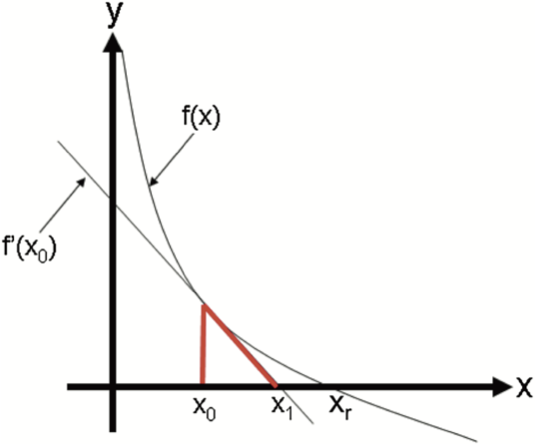
This notebook contains an excerpt from the Python Programming and Numerical Methods - A Guide for Engineers and Scientists, the content is also available at Berkeley Python Numerical Methods.
The copyright of the book belongs to Elsevier. We also have this interactive book online for a better learning experience. The code is released under the MIT license. If you find this content useful, please consider supporting the work on Elsevier or Amazon!
< 19.3 Bisection Method | Contents | 19.5 Root Finding in Python >
Newton-Raphson Method¶
Let \(f(x)\) be a smooth and continuous function and \(x_r\) be an unknown root of \(f(x)\). Now assume that \(x_0\) is a guess for \(x_r\). Unless \(x_0\) is a very lucky guess, \(f(x_0)\) will not be a root. Given this scenario, we want to find an \(x_1\) that is an improvement on \(x_0\) (i.e., closer to \(x_r\) than \(x_0\)). If we assume that \(x_0\) is “close enough” to \(x_r\), then we can improve upon it by taking the linear approximation of \(f(x)\) around \(x_0\), which is a line, and finding the intersection of this line with the x-axis. Written out, the linear approximation of \(f(x)\) around \(x_0\) is \(f(x) \approx f(x_0) + f^{\prime}(x_0)(x-x_0)\). Using this approximation, we find \(x_1\) such that \(f(x_1) = 0\). Plugging these values into the linear approximation results in the equation
which when solved for \(x_1\) is $\( x_1 = x_0 - \frac{f(x_0)}{f^{\prime}(x_0)}. \)$
An illustration of how this linear approximation improves an initial guess is shown in the following figure.

Written generally, a Newton step computes an improved guess, \(x_i\), using a previous guess \(x_{i-1}\), and is given by the equation
The Newton-Raphson Method of finding roots iterates Newton steps from \(x_0\) until the error is less than the tolerance.
TRY IT! Again, the \(\sqrt{2}\) is the root of the function \(f(x) = x^2 - 2\). Using \(x_0 = 1.4\) as a starting point, use the previous equation to estimate \(\sqrt{2}\). Compare this approximation with the value computed by Python’s sqrt function.
import numpy as np
f = lambda x: x**2 - 2
f_prime = lambda x: 2*x
newton_raphson = 1.4 - (f(1.4))/(f_prime(1.4))
print("newton_raphson =", newton_raphson)
print("sqrt(2) =", np.sqrt(2))
newton_raphson = 1.4142857142857144
sqrt(2) = 1.4142135623730951
TRY IT! Write a function \(my\_newton(f, df, x0, tol)\), where the output is an estimation of the root of f, f is a function object \(f(x)\), df is a function object to \(f^{\prime}(x)\), x0 is an initial guess, and tol is the error tolerance. The error measurement should be \(|f(x)|\).
def my_newton(f, df, x0, tol):
# output is an estimation of the root of f
# using the Newton Raphson method
# recursive implementation
if abs(f(x0)) < tol:
return x0
else:
return my_newton(f, df, x0 - f(x0)/df(x0), tol)
TRY IT! Use my_newton= to compute \(\sqrt{2}\) to within tolerance of 1e-6 starting at x0 = 1.5.
estimate = my_newton(f, f_prime, 1.5, 1e-6)
print("estimate =", estimate)
print("sqrt(2) =", np.sqrt(2))
estimate = 1.4142135623746899
sqrt(2) = 1.4142135623730951
If \(x_0\) is close to \(x_r\), then it can be proven that, in general, the Newton-Raphson method converges to \(x_r\) much faster than the bisection method. However since \(x_r\) is initially unknown, there is no way to know if the initial guess is close enough to the root to get this behavior unless some special information about the function is known a priori (e.g., the function has a root close to \(x = 0\)). In addition to this initialization problem, the Newton-Raphson method has other serious limitations. For example, if the derivative at a guess is close to 0, then the Newton step will be very large and probably lead far away from the root. Also, depending on the behavior of the function derivative between \(x_0\) and \(x_r\), the Newton-Raphson method may converge to a different root than \(x_r\) that may not be useful for our engineering application.
TRY IT! Compute a single Newton step to get an improved approximation of the root of the function \(f(x) = x^3 + 3x^2 - 2x - 5\) and an initial guess, \(x_0 = 0.29\).
x0 = 0.29
x1 = x0-(x0**3+3*x0**2-2*x0-5)/(3*x0**2+6*x0-2)
print("x1 =", x1)
x1 = -688.4516883116648
Note that \(f^{\prime}(x_0) = -0.0077\) (close to 0) and the error at \(x_1\) is approximately 324880000 (very large).
TRY IT! Consider the polynomial \(f(x) = x^3 - 100x^2 - x + 100\). This polynomial has a root at \(x = 1\) and \(x = 100\). Use the Newton-Raphson to find a root of \(f\) starting at \(x_0 = 0\).
At \(x_0 = 0, f(x_0) = 100\), and \(f'(x) = -1\). A Newton step gives \(x_1 = 0 - \frac{100}{-1} = 100\), which is a root of \(f\). However, note that this root is much farther from the initial guess than the other root at \(x = 1\), and it may not be the root you wanted from an initial guess of 0.
< 19.3 Bisection Method | Contents | 19.5 Root Finding in Python >
